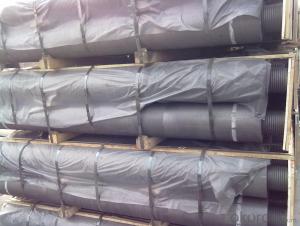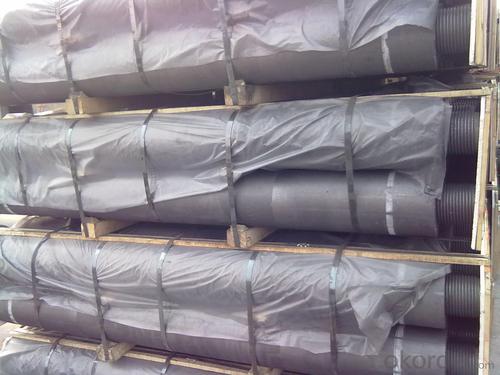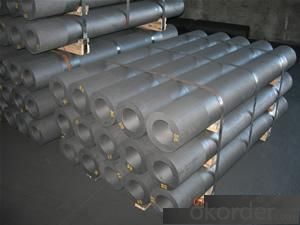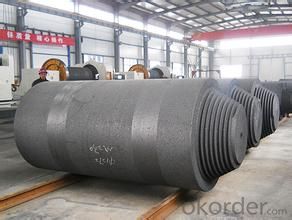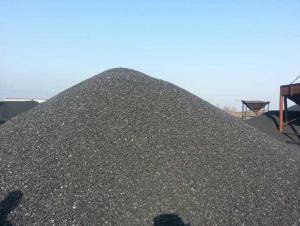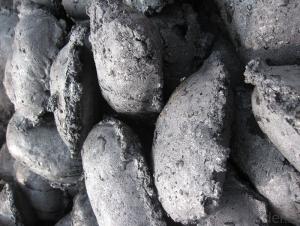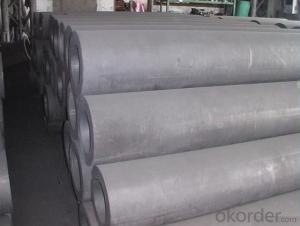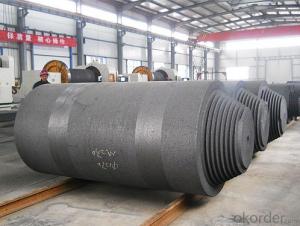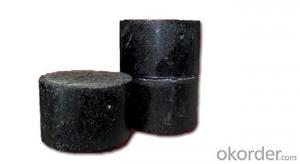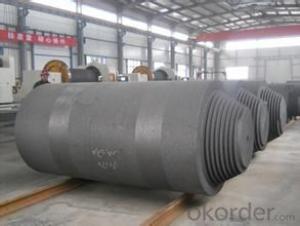Carbon Electrodes with Diameter Φ500 to Φ700
- Loading Port:
- Lianyungang
- Payment Terms:
- TT OR LC
- Min Order Qty:
- 20 m.t.
- Supply Capability:
- 700 m.t./month
OKorder Service Pledge
OKorder Financial Service
You Might Also Like
Spcifications
1:carbon eletrode
2:for ferroalloy,calcium carbide, silicon metal, manufacture
Product Description
Carbon Electrode is abaked electrode used in submerged arc furnaces for delivering power to the charge mix. Electrode is added to the top of the electrode column cylindrical form. Electrode is essentially a mix of Electrically Calcined Anthracite (ECA) or Calcined Petroleum Coke (CPC) with Coal Tar Pitch and is baked for weeks, it is widly used for ferroally productiong, silicon metal production etc.
Graphite/Carbon Electrode Paste Specification:
| PARAMETER UNIT GUARANTEE VALUE | ||||||
| Items | Φ500~Φ700 | Φ750~Φ960 | Φ1020~Φ1400 | |||
| Rs μΩ.m | ≤45 | ≤38 | ≤45 | ≤38 | ≤40 | |
| Bulk Desity g/cm3 | ≥1.55 | ≥1.58 | ≥1.55 | ≥1.58 | ≥1.55 | ≥1.58 |
| Bending Strength MPa | 3.5~7.5 | 4.0~7.5 | 3.5~7.5 | 4.0~7.5 | 3.5~7.5 | 4.0~7.5 |
| Compressive Strength MPa | ≥20.0 | ≥20.0 | ≥20.0 | ≥20.0 | ≥19.0 | ≥19.0 |
| Compressive Strength MPa | 3.2~4.8 | 3.0~4.6 | 3.2~4.8 | 3.0~4.6 | 3.2~4.8 | 3.0~4.6 |
| Ash % | ≤2.5 | ≤2.0 | ≤2.5 | ≤2.0 | ≤2.5 | ≤2.0 |
Picture:
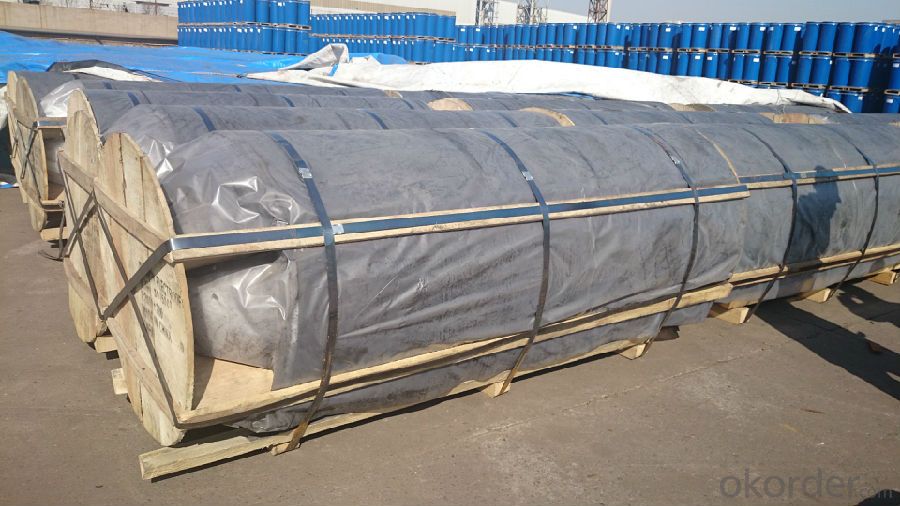
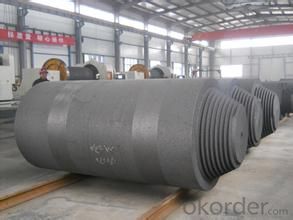
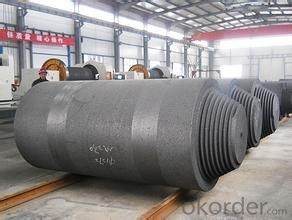
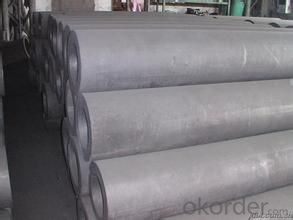
We can adjust the size based on different enquiry. please contact us if you are interested in this materials, we will send our offer as soon as get your kind email.
Do you know how many kinds of our graphite electrode?
1, according to the power, we have regular power, high power, super high power, super high power
and American Ucar standard.
2, according to the shape, we have round shape and square shape.
3, according to the size, the diameter is from 250mm to 700mm.
- Q: What is carbon nanotechnology?
- The study and engineering of materials at the nanoscale using carbon-based materials, such as carbon nanotubes and graphene, is known as carbon nanotechnology. This branch of science focuses on manipulating and examining materials at a scale of 1 to 100 nanometers. Carbon nanotechnology takes advantage of carbon's distinctive properties to create and control nanostructures with exceptional mechanical, electrical, and chemical attributes. For instance, carbon nanotubes are cylindrical structures composed of carbon atoms arranged in a hexagonal lattice. Their unique structure grants them remarkable strength, thermal conductivity, and electrical properties. Consequently, carbon nanotubes have a wide range of potential applications in electronics, energy storage, and materials science. They offer the promise of creating stronger and lighter materials, more efficient batteries, and faster and smaller electronic devices. Another carbon-based material, graphene, is a single layer of carbon atoms arranged in a hexagonal lattice. It possesses exceptional strength, electrical conductivity, and thermal conductivity. Graphene has the potential to revolutionize industries such as electronics, medicine, and energy. Its properties make it an ideal candidate for flexible electronics, high-performance batteries, and even drug delivery systems. The development of methods to synthesize and manipulate carbon-based nanostructures is an essential aspect of carbon nanotechnology. Researchers employ techniques like chemical vapor deposition, laser ablation, and molecular self-assembly to create nanoscale carbon materials. These techniques allow for precise control over the size, shape, and properties of the nanostructures, enabling the design of materials with tailored properties for specific applications. In conclusion, carbon nanotechnology explores the unique properties and applications of carbon-based materials at the nanoscale. It has the potential to revolutionize various industries and create new technologies that can bring numerous benefits to society.
- Q: How is carbon involved in the metabolism of carbohydrates, proteins, and fats?
- The metabolism of carbohydrates, proteins, and fats relies heavily on carbon, a fundamental element. Within all three macronutrients, carbon atoms play a vital role in forming their molecular structures. Carbohydrates contain carbon in the form of glucose, which serves as the body's primary energy source. Through glycolysis, glucose is broken down into smaller molecules, generating ATP for cellular energy. Carbon atoms in glucose are rearranged and converted into intermediate compounds, which are further utilized in other metabolic pathways. In contrast, proteins are intricate molecules made up of amino acids, each containing a carbon atom. During protein metabolism, carbon atoms participate in various reactions, including deamination and transamination, enabling the synthesis or breakdown of proteins. Carbon atoms also contribute to the formation of peptide bonds, linking amino acids together to create the backbone of proteins. In the metabolism of fats or lipids, carbon is predominantly found in the fatty acid chains. These chains provide a high-energy fuel source, as they can be broken down through beta-oxidation. Sequential cleavage of carbon atoms from fatty acids produces acetyl-CoA, which enters the citric acid cycle (also known as the Krebs cycle) to generate ATP. Furthermore, carbon atoms from fatty acids can be utilized for the synthesis of other molecules, such as cholesterol and hormones. In summary, carbon plays a crucial role in the metabolism of carbohydrates, proteins, and fats. Its involvement in these metabolic processes facilitates energy production, the synthesis and breakdown of essential molecules, and the regulation of various physiological functions.
- Q: How much is a ton of carbon fiber? How much difference is made between domestic and imported?
- To 12K carbon fiber, for example, domestic prices between 16~17 million, imports of Dongli carbon fiber prices between 27~29 million.
- Q: How are carbon nanotubes used in various industries?
- Carbon nanotubes are incredibly versatile materials that have found applications in numerous industries. Their unique properties make them ideal for a wide range of uses. In the electronics industry, carbon nanotubes are used to enhance the performance of electronic devices. They can be used as conductive additives in polymers to improve their electrical conductivity, making them suitable for applications such as flexible displays, touchscreens, and wearable electronics. Additionally, carbon nanotubes can be used as field emitters in flat-panel displays, enabling brighter and more energy-efficient screens. The aerospace and automotive industries also benefit from carbon nanotubes. Due to their exceptional strength and low weight, carbon nanotubes are used to manufacture lightweight and durable composites for aircraft and automobile parts. These composites offer improved fuel efficiency, increased load-bearing capacity, and enhanced resistance to impact and corrosion, making them crucial in the development of next-generation vehicles and aircraft. Another industry where carbon nanotubes have made significant contributions is the energy sector. Carbon nanotubes have been used to develop more efficient and durable batteries and supercapacitors. Their high surface area and excellent electrical conductivity enable faster charging and discharging rates, leading to improved energy storage and longer battery life. Moreover, carbon nanotubes are being explored as catalysts for fuel cells, which could revolutionize the clean energy industry by providing a more sustainable and efficient power source. The medical and healthcare industries also utilize carbon nanotubes in various applications. They are used as drug delivery vehicles, allowing targeted delivery of medications to specific cells or tissues, thereby improving treatment efficacy and reducing side effects. Carbon nanotubes are also being investigated for their potential in medical imaging, as they have unique optical properties that can enhance the sensitivity and resolution of imaging techniques such as MRI and CT scans. Furthermore, carbon nanotubes find applications in the construction industry, where they are used to reinforce concrete and enhance its mechanical properties. By adding carbon nanotubes to concrete, it becomes stronger, more durable, and resistant to cracking and corrosion. This can lead to safer and longer-lasting infrastructure, such as bridges and buildings. In conclusion, carbon nanotubes have revolutionized various industries by offering exceptional properties such as high strength, electrical conductivity, and light weight. From electronics to aerospace, energy to healthcare, and construction to automotive, carbon nanotubes have found applications in a multitude of sectors, enabling the development of innovative and advanced technologies.
- Q: How does carbon affect the electrical conductivity of materials?
- Carbon can significantly affect the electrical conductivity of materials due to its unique electronic properties. Carbon atoms, when bonded together in a specific arrangement, can form different allotropes such as graphite, diamond, and fullerenes, each with distinct electrical conductive properties. Graphite, for example, is composed of layers of carbon atoms arranged in a hexagonal lattice structure. Within each layer, carbon atoms form strong covalent bonds, resulting in a stable structure. However, between the layers, weak van der Waals forces exist, allowing for easy movement of electrons in the plane of the layers. This delocalization of electrons in graphite leads to its high electrical conductivity, as the free electrons can move freely and carry electrical charges. On the other hand, diamond, another allotrope of carbon, has a three-dimensional covalent network structure. In this structure, each carbon atom forms four strong covalent bonds with its neighboring atoms, resulting in a highly rigid and stable lattice. The absence of free electrons in diamond restricts the movement of electrical charges, making it an insulator. Fullerenes, which are spherical carbon molecules, can have varying electrical conductive properties depending on their structure. Some fullerenes can behave as semiconductors, meaning their electrical conductivity can be manipulated by introducing impurities or applying external stimuli. In addition to these allotropes, carbon can also be used as a dopant in certain materials to enhance their electrical conductivity. For instance, doping silicon with small amounts of carbon can improve its electrical conductivity, resulting in materials suitable for electronic devices. Overall, carbon's influence on electrical conductivity is highly dependent on its structure and arrangement within a material. Understanding the different forms and properties of carbon can help engineers and scientists design materials with desired electrical conductive characteristics for various applications.
- Q: How does carbon impact the melting of polar ice caps?
- Carbon impacts the melting of polar ice caps primarily through climate change. Carbon dioxide (CO2) is a greenhouse gas that traps heat in the atmosphere, causing the Earth's temperature to rise. This increase in temperature leads to the melting of polar ice caps. When carbon is released into the atmosphere through human activities such as burning fossil fuels, deforestation, and industrial processes, it accumulates and contributes to the greenhouse effect. As the concentration of CO2 increases, more heat is trapped, resulting in the warming of the planet. Polar ice caps, especially in the Arctic and Antarctica, are particularly vulnerable to this warming. The melting of the ice caps is accelerated by rising temperatures, causing them to shrink and eventually collapse. This process is known as ice cap retreat. The impact of carbon on polar ice caps is twofold. Firstly, the melting of ice caps contributes to sea-level rise, which poses a significant threat to coastal communities and low-lying areas worldwide. As the ice caps melt, the water from them flows into the oceans, causing them to expand. This can lead to coastal erosion, increased flooding, and the loss of valuable habitats and ecosystems. Secondly, the melting of polar ice caps also disrupts the delicate balance of the Earth's climate system. The reflective surface of ice helps to regulate the planet's temperature by reflecting sunlight back into space. As the ice melts, it is replaced by darker surfaces such as water or land, which absorb more heat. This further exacerbates global warming, creating a feedback loop that accelerates the melting process. Overall, the impact of carbon on the melting of polar ice caps is profound. The continued release of carbon into the atmosphere is contributing to the loss of these critical ecosystems, causing sea-level rise, and disrupting the Earth's climate system. To mitigate these effects, it is crucial to reduce carbon emissions and transition to cleaner and more sustainable sources of energy.
- Q: What are the effects of carbon emissions on the stability of grasslands?
- Grasslands are significantly impacted by carbon emissions, which have various negative effects. One major consequence is the modification of the climate, particularly through the greenhouse effect. Carbon dioxide (CO2) is a primary greenhouse gas, and the higher concentration of CO2 in the atmosphere leads to global warming. This rise in temperature disrupts the natural growth patterns of grasslands and disturbs the delicate balance of their ecosystems. The increased temperatures caused by carbon emissions can result in higher rates of evaporation, leading to drier soil conditions. Grasslands are adapted to specific levels of moisture, and any alterations in these conditions can reduce plant growth and increase vulnerability to drought. Consequently, grasslands become less stable and more susceptible to desertification. Furthermore, elevated levels of carbon dioxide can impact the nutritional quality of grasses. As CO2 concentrations rise, the relative proportion of essential nutrients in grasses may decrease. This phenomenon, called nutrient dilution, can affect the health and productivity of herbivores that depend on these grasslands for sustenance. The decline in nutritional value disrupts the delicate balance of predator-prey relationships and contributes to a decrease in biodiversity. In addition, carbon emissions contribute to soil acidification. Increased carbon dioxide dissolves in rainwater, forming carbonic acid, which lowers the pH of the soil. Grasses are sensitive to changes in soil pH, and acidification negatively affects their growth and nutrient absorption. Acidic soil conditions can also lead to the loss of crucial microorganisms that contribute to a healthy soil ecosystem, further destabilizing grasslands. Lastly, carbon emissions indirectly affect grasslands through climate change-induced changes in precipitation patterns. Shifts in rainfall patterns can alter the composition and distribution of plants, favoring invasive species or disrupting the competitive balance between different grass species. This disturbance can compromise the stability and functioning of grassland ecosystems. In conclusion, carbon emissions have multiple detrimental effects on the stability of grasslands, including climate changes, increased susceptibility to drought, nutrient dilution, soil acidification, and alterations in precipitation patterns. It is essential to reduce carbon emissions and mitigate the impacts of climate change to preserve the stability and integrity of grassland ecosystems.
- Q: What is the burning point of carbon?
- There are many forms of carbon, such as charcoal, coal, and even diamonds!And different forms have different ignition points!
- Q: How dnf advanced carbon ashes?
- Mall has sold, and sometimes activities, and now there is no
- Q: Carbon Finance: Carbon Finance
- The "Framework Convention" is the world's first comprehensive control of carbon dioxide and other greenhouse gas emissions, the International Convention for the human economic and social adverse effects in response to global warming, a basic framework is also the international society for international cooperation in tackling global climate change on the issue. According to statistics, 191 countries have ratified the Convention at present. These countries are called parties to the convention. The parties to the Convention have made many pledges aimed at addressing climate change. Each party must submit periodic reports, which contain the greenhouse gas emission information of the contracting parties and indicate plans and specific measures for the implementation of the convention. The Convention came into force in March 1994 and laid the legal foundation for international cooperation in dealing with climate change. It was an authoritative, universal and comprehensive international framework. The Convention consists of a preamble and 26 main texts. The Convention is legally binding to control emissions of carbon dioxide, methane and other greenhouse gases in the atmosphere and stabilize the concentration of greenhouse gases from the destruction of the climate system. The Convention differs from the developed countries and developing countries in terms of their obligations and procedures for fulfilling their obligations.
Send your message to us
Carbon Electrodes with Diameter Φ500 to Φ700
- Loading Port:
- Lianyungang
- Payment Terms:
- TT OR LC
- Min Order Qty:
- 20 m.t.
- Supply Capability:
- 700 m.t./month
OKorder Service Pledge
OKorder Financial Service
Similar products
Hot products
Hot Searches
